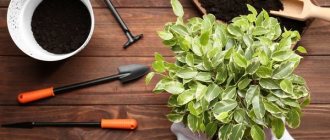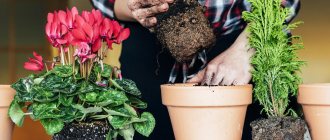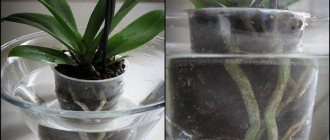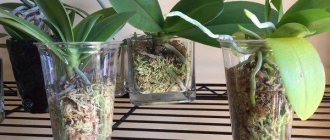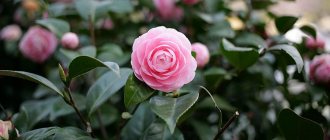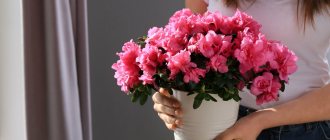- December 31, 2019
- Country house
- Maria Tatarova
There are indoor plants in almost every apartment. They are part of the interior and create a cozy atmosphere. But in addition to aesthetic pleasure, plants also perform a very important function for humans: they participate in the formation of oxygen, without which humans simply cannot live. Houseplants, unlike their “relatives” living in nature, are in an artificial environment and therefore require special care. One of its important components is plant transplantation. A serious question is which day is best to replant indoor flowers.
Types and methods of transplantation
There are two types of transplantation: planned and emergency. When planning, it is decided in advance which days it is better to replant indoor flowers. An emergency transplant is necessary if the pot is damaged or the flower is suddenly affected by any disease. But still, turning to replanting as a way to cure a plant should be done only as a last resort, when other means have not helped. The fact is that replanting flowers is stressful. Therefore, it is so important to understand on which days you can replant indoor plants and on which days you cannot.
There are three ways to transplant indoor flowers.
- Full. The soil changes completely, every root is shaken off the ground. The most stressful method of transplantation for a plant.
- Incomplete. The roots are placed in a new pot along with a lump of earth adjacent to the roots.
- Replacement of topsoil. The soil is loosened, the top layer is poured out and new soil is added. The most gentle way for the flower.
How to plant a flower correctly?
Specialist flower growers recommend three options for transplanting indoor flowers:
- complete transplant;
- transferring the plant with a lump of earth into a larger pot;
- partial replacement of soil.
The first two methods are identical to each other and are performed in the same sequence.
In the last paragraph the instructions are as follows:
- The top layer of soil is loosened to a depth of 5-7 cm, then poured out of the container.
- During loosening, it is important not to touch the root system.
- The vacated space is covered with a new layer of soil and lightly compacted.
- After this procedure, the flower must be watered.
Features and Rules
Before planting a flower, you must follow some rules. Firstly, take into account the age of the flower, and secondly, you need to purchase new soil in advance from the store or prepare it yourself, taking into account all the requirements of this type of plant.
As we have already said, young plants require an annual replanting procedure due to rapid growth and development, and specimens older than 3 years can get by with replacing the top layer of soil, which is carried out 1-2 times a year.
We select the pot in accordance with the basic requirements:
- diameter and depth - 2-3 cm more than before;
- with a sufficient number of drainage holes to drain excess moisture;
- The pot material should protect the roots from hypothermia and overheating.
Instead of drainage holes, you can use expanded clay or crushed stone; pebbles or broken bricks will do. The material is pre-fired in the oven or poured with boiling water to disinfect and avoid the introduction of pests.
We will make sure in advance that you have a scoop, spatula, garden shears, knife, and gloves. It is better to disinfect tools. Let's prepare charcoal or ash. You can take another antiseptic.
Step-by-step instruction
- We’ll put all the necessary materials in one place so you don’t have to look for them if necessary, and you can get to work.
- Soak the new pot in water for 30-40 minutes to soak it in moisture. If we take a used pot, we clean it of old soil, dirt, salts, wash it and pour boiling water over it.
- Place the pot with the plant in water for 20-30 minutes.
- Fill the new pot with drainage, a layer of 2-3 cm.
- Pour a small layer of fresh soil onto the drainage layer, making a small mound in the center.
- We take the flower out of the old pot along with a lump of earth. This is done like this: turn the pot over with the flower facing down and, holding the flower, pull on the container until it comes off.
- If it is not possible to remove the plant in this way, then we take a spatula to help and, inserting it between the walls and the ground, we pass the pot in a circle.
- When transferring the plant, we lower the roots and soil into the center of the pot, and fill the free space between the walls and the lump with new soil, periodically compacting the soil with our fingers.
- In case of a complete transplant, completely shake off the soil from the roots. We check the roots: remove dry and rotten ones with a knife or pruning shears until they reach living material, and treat the cut areas with coal or ash.
- We lower the plant into the pot in the center so that the root is 1.5-2 cm below the edge. We distribute the roots evenly over the entire surface. We fill the free space with fresh soil, lightly compacting it. We fill the soil up to the level of the root rosette.
- Be sure to water the flower, sprinkle dry soil on top and place it in the shade for 5-7 days.
When is a transplant required?
You should not replant the plant thoughtlessly. This can lead to the fact that it simply cannot withstand the load and dies. But the same fate may await it if it is not replanted at all. In this matter, it is important to know when it is time to transplant flowers. Young indoor plants that are no more than 3-4 years old need to be replanted every year. The reason is that the root system of the flower grows and it needs more and more space. If there is not enough space, the color will simply fade. Plants older than 3-4 years do not need to be replanted every year. This is extra stress for them. This should be done when necessary, according to certain signs.
How to understand that a flower needs replanting?
- The plant has grown, and it is clear that the roots are cramped in this pot.
- The plant begins to fade, lose strength and beauty. The leaves droop, turn yellow, the plant does not bloom or blooms poorly. Perhaps the soil has become depleted. The minerals needed by the flower have become scarce, so the substrate needs to be updated.
It is important not to forget to periodically feed the flower.
Transplanting perennial flowers in garden beds
All of them are divided into two large groups:
- winterers, that is, those who are not afraid of the winter cold and survive it in their flowerbed or alpine hill;
- not overwintering, requiring annual digging and storage in special conditions until the next growing season.
The second group includes dahlias, gladioli, and other species, most of which are bulbous. These cultures require a personal approach. But what about those that do not need to be removed from the ground every year and grow well in one place for several years?
- perennials bloom less;
- the once lush clumps in the center are thinning out;
- plants gradually take over neighboring areas.
In this case, the perennial crop requires transplantation and rejuvenation. How, when and with what frequency is it better to carry out this procedure?
What time of year to replant?
On what days can you replant indoor flowers? First, let's decide on the time of year.
The best time is spring. At this time, all nature wakes up, comes to life, and gains strength. In spring, it will be easier for flowers to tolerate such significant changes in their living environment. And besides, it is in the spring that plants need more minerals. Flowers at this time enter an active phase of life: they grow, prepare for an important period - flowering. Most plants bloom in summer. This takes all the energy, so replanting at this time of year is undesirable. On what days should I replant indoor flowers in the fall? Better - in September. The plant has finished flowering, but has not yet gone into hibernation. If indoor flowers were transplanted into the garden for the summer, then in September it’s time to return them back to the pots. Starting in late autumn and throughout the winter, the houseplant should not be disturbed. The phase of calm or sleep begins. All processes in the plant slow down, so it may not survive transplantation. And even an emergency transplant should be postponed if possible. For example, if the pot did not break, but cracked, then you can wait to replant.
When and how often should you replant?
If you notice thin roots growing through the drainage holes, then this is a clear sign of a necessary transplant. It is also required if the roots of the plant have filled the entire space of the pot and they have become crowded.
In addition to the planned transplant, urgent reasons may arise:
- the roots began to rot;
- the pot broke;
- the earth is rotten or pests have infested it.
If you do not replant the flower in a timely manner, it may die.
What time of day
When choosing on what day to transplant flowers into different soil, it is important to focus on both the time of day and the weather. As experienced gardeners advise, it is better that the weather is cloudy and warm, but not hot. Heat is unfavorable for the plant, as is cold, so warm and cloudy weather is just right. It is better to do this from 16:00 to 19:00. In the morning the plant has not yet woken up, and in the afternoon it is already hot, so you should not disturb it at this time.
Transfer on a specific day
When planting or replanting flowers on a certain date, pay attention to the tables. Having found today's date, they look at the sign that is written there. If there is a disk drawn on it, on which the crescent moon is marked on the right, then it is allowed.
Designations of moon phases on calendars
How to determine the days for transplantation
Favorable days for replanting indoor plants will be marked on the lunar chart with the symbols of the waxing and waning of the Moon. The growth phase allows you to replant all flowers that please with the upper part: flowers or leaves. At this time, the roots are strong and will withstand any transplants. In the 3rd and 4th phases, as an exception, it is permissible to replant tuberous plants.
Important! During the full moon, you should not touch not only the plant itself, but also the soil under it. Any damage to the stems or root system can destroy the flowers.
Moon phases
In September 2022, the Moon experiences the following changes:
- from the 1st to the 13th of the month - the Moon is growing, when indoor flowers and groups of decorative foliage are subject to replanting;
- September 14 – full moon, nothing is replanted;
- from the 15th to the 27th – the moon is waning, they work with bulbous and tuberous flowers;
- September 28 is the new moon, flowers are not touched.
- On the 29th and 30th – the Earth’s satellite is growing again, you can start replanting ornamental plants.
Not only flower transplantation, but also the sowing season, when seeds, bulbs or tubers are planted in the ground, depends on the night light.
An important role is played by the zodiac signs (according to the horoscope) in which the satellite is located:
- September 1, 2, 3, 4, 8, 9, 13, 18, 19, 22, 23, 24, 30 – fertile signs – Taurus, Libra, Capricorn, Pisces, Scorpio, Cancer;
- September 5, 6, 7, 20, 21, 26, 27 – less fertile – Sagittarius, Virgo, Gemini;
- September 10, 11, 12, 15, 16, 17, 25 – barren – Aries, Leo and Aquarius.
Moon calendar for 2022
According to the lunar calendar
Scientists have proven that the Moon influences the movement of water on Earth. And not only on the ebb and flow of tides, but also on the movement of fluid in organisms, including sap in plants. Therefore, a good gardener, when determining on what day to replant flowers in a different soil, will also pay attention to the phase of the moon. Why does the movement of sap in a flower affect transplantation? The fact is that it is impossible to replant a plant without damaging the roots. Therefore, it is better that during replanting the juice is in the above-ground part of the plant, and not in the roots. This occurs on the full moon, which takes three days (the day of the full moon itself and one day before and after it). During the full moon, the largest accumulation of sap occurs in the above-ground part of the plant, making this the most optimal time for replanting. A less suitable phase, but still acceptable, is the waxing Moon. At this time, the liquid is still moving from the roots to the top. The phases of the waning moon and the new moon are the most unfavorable. During the waning moon, the sap is directed to the roots, and on the new moon, all nutrition is concentrated in the roots. If you damage them during this period, the plant may die.
What is important to consider when replanting houseplants?
The root system of any representative of the flora develops, absorbing all nutrients from the soil. As the roots grow, it becomes a little cramped in the pot. The purpose of replanting is to enable the plant to continue to grow, since the procedure stimulates the appearance of new shoots.
The frequency of procedures for various flowers differs depending on the variety and variety of crop. There are plants that are recommended to be replanted annually and those that should not be disturbed for at least several years. Cacti and succulents can grow fully in one container for up to 6 years.
Don't forget about the frequency of transfers. A young plant that is intensively gaining root mass should be regularly placed in a spacious container with renewed soil once a year. The development of a flower aged 2-3 years is significantly reduced and the number of its replantings is also reduced.
It is important to note that this procedure is considered stressful for plants, which is why it must be performed only in certain situations.
Causes:
- Accumulation of salts in the soil that came from irrigation water. This makes it difficult for plants to feed.
- The smell of swamp rot or the rapid drying out of the earth.
- Compaction of the soil substrate, which causes oxygen starvation of the roots.
- Depletion of soil, decomposition of its organic component, due to which the application of fertilizers becomes ineffective.
- The presence of a whitish coating on the top layer of soil.
- Detection of harmful insects.
- The roots grow and displace the soil from the pot, making watering difficult.
- Termination or slowdown of growth of the ground part. Especially at a time when flowers should grow intensively, but they do not form new shoots and do not develop.
- Disturbance of flowering - shortened time, a small number of flowers or their underdevelopment and earlier fall.
It is recommended to plan a transplant on the allotted days prescribed in the lunar calendar. It is believed that during these periods of time, plants normally adapt to new conditions and are able to take root instantly.
After purchase or planned
Transplants can be carried out urgently and according to plan. Planned - most often carried out in the spring, before the start of a period of intensive growth. At this moment, the flowers awaken after the cold winter and begin to actively develop. Such plants survive stress better, adapt and recover in a new habitat. Sent to a fresh nutrient substrate, they receive a huge dose of energy for normal growth and gorgeous flowering.
Also read: How to properly transplant hyacinth: step-by-step instructions with photos
Emergency replanting of domestic plants is carried out if:
- There is a suspicion that the roots have begun to rot.
- The soil became acidic after overwatering.
- The leaves begin to dry out.
- The pot burst.
In these cases, the procedure must be performed at any time, even at the moment of flowering, otherwise the flower may die.
There is no need to rush to replant a newly purchased plant. It should not be touched, but should be left in a shipping container for adaptation for 15-20 days. The new inhabitant of the house needs this time to acclimatize. Otherwise, moving to another room may end disastrously for it - an indoor flower will not tolerate double stress.
It is also contraindicated to replant the plant:
- During the resting phase (late autumn-winter), since all biological processes are suspended, the humidity in the room decreases, temperature fluctuations occur and daylight hours are reduced. This will prevent the plant from recovering after the operation. It is important to additionally feed the shoots, increase the soil layer and wait until spring comes.
- During flowering , since all forces are spent on the formation of ovaries, flowers, and fruits. The procedure can cause the death of a green pet.
- For various diseases , since the shoots are weakened and cannot cope with the load.
The main thing is to carefully monitor the growth of flowers and build a replanting schedule in accordance with this.
Time of year and month
Also, the transplant must be planned taking into account the time of year and month:
- Spring is an ideal period, since most house flowers have depleted the substrate in which they grew over the winter. And some, with the beginning of spring, did not produce new shoots, and also began to lose old foliage. This is a signal to renew the soil and replace the pot. Transplanting to any crop has a positive effect, so in March or April it is necessary to devote 2-3 days to this important procedure. In these months, it becomes warmer and the length of daylight increases, which is suitable for resuming work with plants.
- Summer . Flowering occurs in the warmer months. If the flowers have released buds, then replanting should be delayed.
- Autumn . Some varieties of flowers require replanting in the autumn months. There are plants with fast-growing roots that fill the entire flowerpot at the moment of intensive growth, which is why they need another procedure in early September.
- Winter . During the cold months, plants experience a pronounced dormant period, so you should refrain from changing the pot.
When planning transplantation work, you should take into account that every month has good and bad days.
Also read: Replanting an orchid correctly: step-by-step instructions with photos
Day of the week
People who are passionate about floriculture recommend holding the event on days with a feminine name (Wednesday, Friday, Saturday) . This is an acceptable period of time for relocating a plant, as well as for rejuvenating bushes that have grown and lost their decorative appearance.
Times of Day
In order for indoor crops to grow well and bloom luxuriously, you need to take into account what time of day it is most successful to transplant them. The most optimal period is from 16.00 to 20.00, before sunset, because:
- In the morning, plants are just waking up and are not prepared for a stressful situation.
- During the midday hours, the procedure performed will negatively affect subsequent growth.
- During the night, weakened flowers will not be exposed to increased daytime temperatures and will have time to take root.
If an emergency transplant is necessary in winter, it is better to perform the operation during the day, before the temperature drops.
Influence of zodiac signs
Days when the Moon passes through the zodiac signs of Water and Earth are suitable for all kinds of care procedures. On a new moon or full moon, it is better not to perform any operations with flowers.
- Water signs
Cancer , Scorpio - favor working with representatives of the flora. Therefore, any care is recommended on the days when the Moon passes these zodiac signs. Pisces are also favorable to replanting plants; the main thing these days is not to overdo it with watering, this can lead to rotting of the roots.
- Earth Signs
If you change the flowerpot and soil during the period of Taurus , the plants will take root normally. At the time of Capricorn, replanting will lead to the fact that home flowers will have good immunity to diseases and harmful insects, and will also be able to please with a powerful and healthy root system. Virgo is the patroness of abundant flowering, which is why it is worth replanting beautifully flowering potted plants at this time.
Fire signs (Leo, Aries, Sagittarius) are not suitable for carrying out agricultural techniques for caring for plants. And the zodiac constellations of Air (Libra, Gemini, Aquarius) are neutral and are recommended for caring for flowering crops.
It is often noted that transplantation carried out under the negative influence of the moon or zodiac constellations leads to the fact that the flowers will have a very difficult time surviving the adaptive period.
Moon influence
Days of solar and lunar eclipses are not suitable for replanting plants. They are too sensitive at this moment, and even a small injury can cause death.
The moon goes through a full cycle in 29.5 Earth days, while it lingers in each zodiac constellation for 2-2.5 days, changing the emotional background and nature of the impact each time. There are three factors influencing the earth’s satellite on everything growing:
- Lunar phases. When the moon is growing, there is an influx of sap to the foliage, and this is the period of time acceptable for replanting. During the waning phase, flowers begin to accumulate moisture, and operations with the roots are prohibited. Also, the new moon (the time of transition from the waning moon to the waxing one) is not suitable for the event. During this phase, flowers are very vulnerable to influence. The full moon is another period when you do not need to perform any actions.
- Zodiac sign. Each constellation has its own influence on indoor flowers. The lunar calendar allows you to determine the most optimal time for replanting, adding nutrients, moisturizing or forming the crown. This is a proven way to determine planting day.
- Lunar calendar day . It is contraindicated to carry out procedures on days 1, 4, 9, 15, 18, 23, 26, 29, even if they are favorable in other aspects.
It is prohibited to plan replanting or pruning plants during lunar eclipses, 3-4 days before and after it.
Which pot to choose
In addition to deciding on what day to transplant flowers into another container, the choice of pot also matters. Which is better - plastic or ceramic? Each has its own pros and cons. It is difficult for air to circulate through the walls of a plastic pot, so the oxygen necessary for growth is poorly supplied to the roots. But the moisture lasts longer. Accordingly, in a ceramic pot without glaze coating, air circulates through the walls more easily, but moisture also evaporates faster. Of course, pots also differ in weight: ceramic ones are much heavier than plastic ones. It is best to choose a pot based on the characteristics of the flower for which it is intended. For example, a plastic pot is suitable for ferns and palm trees that love moisture, and a ceramic pot is suitable for cactus plants. You must also remember that there should be holes at the bottom of the pot to create breathability.
What to do before transplant
Before transplanting, you need to buy everything you need in advance. When choosing a pot, you should correctly determine the required dimensions. It should be no more than 5 cm larger in height and width than the previous one.
If a new pot is purchased for replanting, it is washed from the inside with plain water. Before the procedure, old flowerpots must be thoroughly washed of the previous soil . This will prevent the development of pathogens that may have remained in the used pot.
It is better to soak clay or ceramic containers for a day in a soapy solution, then wash the inside with a brush.
What soil to use
There are two options here: buy a ready-made substrate or prepare it yourself. The first option is the simplest. But there is a minus here. Each plant prefers its own soil composition. For example, some plants need more sand, others need peat, and others need turf. Ready-made soil sold in stores usually contains an average composition of components and may not be suitable for some plants. It is best to prepare the substrate separately for each flower in accordance with its preferences. This will create favorable conditions for growth and development.
Features of transplantation during flowering in spring or summer
To transplant a flowering plant you need to prepare:
- Sadly, all flowers should be cut, and as close to the ground as possible. You can immediately get rid of dry leaves.
- Then, after examining the plant, cut off too old leaves and very young ones, so that during the adaptation period the plant does not waste its energy on them.
The flower should be replanted like this::
- It is transplanted from a transport pot into a permanent flower without destroying the root ball, using the transshipment method.
- To do this, choose a pot 2-3 cm larger in diameter, pour expanded clay onto the bottom for drainage and prepare a nutritious earthen mixture in a separate container. It should be loose and fertile. Taking into account the composition of the soil in the habitats of plants in nature, you can create a soil mixture for home spathiphyllum from three parts of peat, two parts of garden soil, two parts of perlite and three parts of substrate for orchids, which in turn consists of charcoal, bark and gravel.
- Water the flower well so that the soil is moist, separate it from the walls and move the plant with a lump of earth into a new pot, having first poured a layer of soil onto the drainage. If the earthen lump does not come out of the pot, you can carefully move it away from the walls with the blade of a knife.
- Fill the sides and top with prepared soil and compact lightly. Water the plant again, wait until the water appears in the pan, then drain it. This can prevent root rotting.
- Place the flower pot in a dark place, away from drafts.
- After 5 hours, spray with epin solution (2 drops per glass of water) - this will speed up rooting. After 7 days, spray again.
Important! Do not water the plant after replanting, but only spray the leaves with water. The first watering is possible on the fifth day.
Sequence of actions during transplantation
- Determine in advance on what day you can replant flowers in a different soil.
- Prepare the soil and pot. Both the new and the already used pot must be soaked in boiling water for a while, washed and dried. This is necessary in order to kill all pathogenic bacteria. This is especially important if the flower that grew in this pot was sick.
- The flower must be watered abundantly within 24 hours so that the soil fits tightly to the roots and they are damaged as little as possible during replanting.
- Sprinkle drainage on the bottom of the pot. To do this, you can use broken brick or ceramics, shards, pebbles, crushed stone or gravel. Drainage creates air circulation, prevents the soil from compacting and becoming rocky, and helps water to be evenly distributed so that pockets of high humidity do not form, which can sour and lead to rotting of the roots.
- Add some soil to the pot.
- Turn the pot with the plant upside down, carefully turning the container and dragging it up. If the soil adheres tightly to the walls, you can insert a spatula to help the soil separate.
- Further actions depend on the method of transplantation. If it is incomplete, the earthen lump is lightly shaken off and placed in the center of a new pot. When replanting completely, the roots must be completely cleared of soil. This must be done carefully, trying to damage them as little as possible. After which you need to carefully examine the roots. If they are rotten or dry, the roots need to be cut back to the point where the rot or dryness ends. And then the plant is also placed in the center of the pot.
- The plant should be placed in the pot approximately 2 centimeters below the rim of the container. After this, you need to fill the remaining free space in the pot with soil, compacting the soil with your fingers.
- The flower needs to be watered. And sprinkle dry soil on top. If during the replanting process many roots were damaged or removed, you should not water the plant.
The effect of transplantation on orchid flowering
It is known that an orchid can bloom for more than 10 months, so many gardeners do not know whether it is possible to replant an orchid when it is blooming. After all, the owners are afraid that the flowers may fade after the procedure and all the buds will fall off. But replanting while the orchid is blooming is possible, and it will not in any way affect what the new bloom will be like.
By the way, you can even prolong flowering if, before planting an orchid in a new pot, you shorten all the flower stalks that are already there by about 2 centimeters. This will help grow a new root mass while producing even more side flowers.
Care after transplant
After transplantation, the plant needs to create conditions for favorable recovery. To do this, the flower needs to be placed in the shade for about a week. At this time, there is no need to water it abundantly, since after suffering stress, water absorption deteriorates, and excess moisture can cause rotting or the spread of infections. After a month, the flower needs to be fed using the fertilizer it needs.
Transplanting flowers is necessary and beneficial for plant growth. But you need to carry out this procedure, which is difficult for him to tolerate, knowing at what time it is better to replant indoor flowers, so that it is easier for them to adapt to the new environment.
Basic Rules
The procedure will be successful and will not harm the plant if you follow the rules:
- Carefully remove the orchid from the pot.
- Free the root system from the old substrate, removing dry or rotten tips.
- Trim the flower stalk if necessary.
- Place in a container with new soil.
- Complete watering.
Then the plant needs to be placed on the windowsill, shading it for a while.
For detailed step-by-step instructions for transplanting, see here.
Is it possible to replant flowers in the evening?
Agree, flowers in the house are a joy for the soul, a kind of little oasis, looking at which we give rest to both our nerves and our eyes tired of the computer and TV.
Moreover, most flowers do not require our constant attention; most often they only have to be watered, and all other “operations” must be carried out from time to time - fertilizing, spraying, replanting.
And today we will master the most important operation, we will learn how to correctly replant indoor flowers that have long taken root in our home, and flowers purchased in a store.
So, based on our requests, we chose a flower and, satisfied with the purchase, brought it home. Now it is imperative to follow all the rules for transplantation, otherwise after a while you will have to hold a funeral ceremony to remove the dried “body”. Or, at best, the flower will hurt for a long time, get used to it, but will never become as beautiful as it was at first.
Transplanting purchased flowers has its own nuances, during which housewives often make the same mistakes. If you are planning to transplant a pet that has already settled in with you, then points 3-5 will be useful to you.
- 1 5 main mistakes when replanting purchased flowers 1.1 1. The first mistake - after purchase, the plant is immediately placed next to other home flowers
- 1.2 2. The second and most important mistake is that a flower bought in a store is left to grow in the same pot in which it was sold.
- 1.3 3. Third mistake - incorrectly selected soil
- 1.4 4. Fourth mistake - flower transplantation is carried out according to a sparing scheme
- 1.5 5. Fifth mistake – early feeding of plants
Determining the optimal timing
It is recommended to change the soil of the flower during the waxing phase of the moon. You can determine it by looking at a special lunar calendar. Experts recommend changing the soil at specific periods. These are the spring months - March and May, the summer months - July and August, the whole autumn without restrictions (on favorable days), and the winter months - December.
These tips are based on years of research. It is believed that on the mentioned dates the change of habitat occurs less painfully, and the negative effects are little perceived by plants.
Is it possible to replant flowers in the evening?
By all indications, it is not advisable; it is advisable to replant flowers on the waxing moon and before sunset. So that they grow quickly and please the owner. Well, if there is such a hopelessness, then you can try, but still adhere to the lunar calendar and still rely on the waxing moon.
Replanting flowers in the evening is not only possible, but also desirable. Transplanting before the cool of the night gives the plants the opportunity to rest at least for a few hours from the possible heat and more easily endure this difficult period for them.
I do not accept all other signs, since they are not scientific. She transplanted the flowers herself in the evening, just before sunset. As a result, the flowers accepted, grew, bloomed and made us happy.
When replanting, look not at the clock hand, but at what kind of weather they predict tomorrow. Choose a period so that the next day there is no great heat. Calm and sunless weather is very suitable.
It is possible, but there are some nuances and signs.
In spring and summer, you can replant flowers in the evening; it will even be better for them, because during the night the plant will acclimatize, and the sun’s rays will not have time to disturb it. In winter, when there is little sun and it does not shine intensely, it is better to replant during daylight hours.
If the flowers are in a period of rapid flowering, then replanting is not recommended at all.
But if you just need to move it to a larger pot (I think this is called transshipment, when clods of earth remain on the roots and are not shaken off when replanting), then you can do this without fear, at any time, at any time of the day.
And now about the signs: we are transplanting to the waxing moon and, preferably, the day of the week should be female (Wednesday, Friday, Saturday).
Of course you can, I have been growing indoor flowers for a long time, and no matter what day it is, whether the moon is waxing or not, in the morning or evening, my indoor flowers essentially grow as usual and are quickly accepted.
And it is still advisable to replant in the evening; if you replant in the summer in the heat, then the evening is just right - the flowers will not hurt so much after replanting.
The main thing is to replant correctly, but I would still recommend watering it in a tray - it will start so quickly.
It is best to replant flowers in the evening, just like other plants. Just when replanting, please note that many flowers are oriented towards the sun and it is better to plant them so that they spend as little energy as possible turning the leaves and flowers the next day. If the weather is cloudless the next day, it is better to cover especially tender plants from the sun's rays for several days.
It’s not just possible, but necessary. I don’t know what the signs are, but it’s easier for a plant to recover overnight. Of course, if these are indoor flowers, you can replant them during the day, the main thing is not to place them in the sun after replanting. But if you have outdoor flowers, then only in the evening or on cloudy days the weather is being transplanted.
If you rely only on your own experience, then this is the best time for a transplant. Evening and night coolness will help the flowers adapt to new conditions. The plant takes root better. And if there is a need to transplant during the day, then you still need to shade it.
You can replant indoor flowers and garden flowers in the evening. Personally, I replanted it, everything was fine with the flower, the flower did not dry out, did not wilt, and the leaves did not wrinkle. I didn’t rely on any lunar calendar, I just transplanted it and that’s it.
The time of day does not play any role, the main thing is to transplant it correctly. Some open ground plants are generally recommended to be replanted in the evening.
There is a sign that replanting flowers in the evening is not very good. That the plant will not take root in the new pot. But these are just superstitions. My flowers felt great. There is also a lunar calendar, according to which you can see when the favorable days are for planting.
Tips for flower growers
- Gradually increase the size and volume of the pot. A sharp jump to large containers will lead to slower growth.
- The clay pot should be placed in water overnight and the drainage hole should be filled with shards before adding new soil.
- Choose soil taking into account the preferences of a particular species. Universal mixtures may not meet the requirements, so flower growers resort to making their own compositions with the obligatory addition of peat.
- If the roots have gripped the earthen ball too tightly or the root system is underdeveloped , then you will need to carefully clean it of adhering soil using a knife or fork.
- Only adapted plants that have already become comfortable after transportation can be replanted. You should not change the soil in the first days after purchasing a flower!
- Be sure to place a layer of drainage at the bottom of the pot (its thickness varies depending on the type of flower).
- Each species requires a special attitude towards its root system: some plants require root pruning , while in others it is strictly forbidden to trim shoots. Check with specialists for handling roots.
- The best pot material is clay. It ensures proper air exchange and simplifies the development of the plant and working with it. Plastic analogues often cause delayed development and disease.
If you follow these rules, your plant will live the entire allotted period and will develop correctly and naturally.
Soil selection
In gardening and flower departments there is a large selection of soil intended for replanting indoor flowers from different groups (for example, soil for palm trees, for ferns, for orchids). However, such a substrate is usually more expensive than a universal soil.
Choosing a soil mixture specifically designed for your pet gives a better chance for its full development and abundant flowering (for flowering specimens).
But for most unpretentious plants, universal soil is sufficient. It should be loose, light, air and water permeable.
To check that the ground is sufficiently permeable to water, it is worth conducting a small experiment. Fill the pot with soil and water generously. Water should drain through the holes. If this does not happen, then the soil should be mixed with a small amount of coarse sand, fine gravel or perlite.
How to get rid of mold in a flowerpot
When transplanting moisture-loving flowers, you should think about adding a special hydrogel to the soil, which, when watering, absorbs excess water and releases it to the plant when the soil in the pot dries out.
Thanks to this, we can increase the time between next waterings (useful if you are planning to go on vacation). But above all, the hydrogel provides continuous access to moisture, promoting lush growth and abundant flowering.
